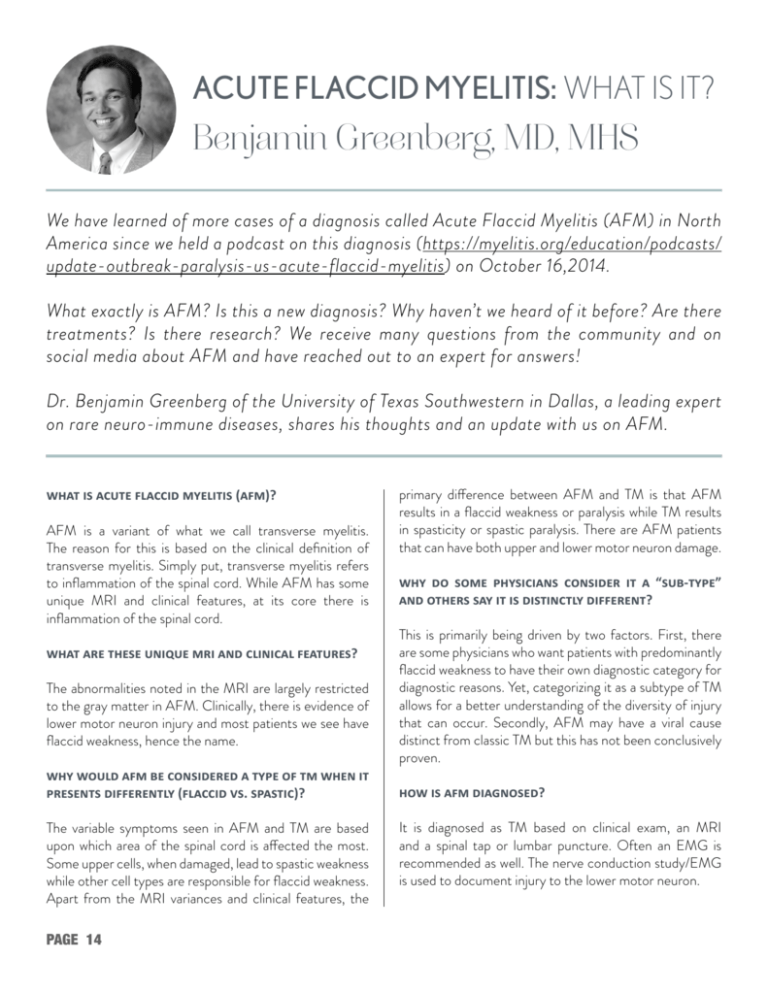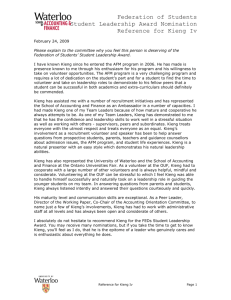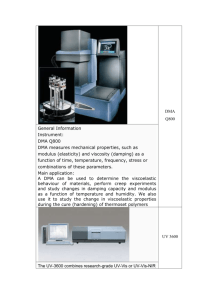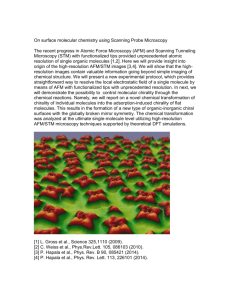Acute Flaccid Myelitis - The Transverse Myelitis Association
advertisement

ACUTE FLACCID MYELITIS: WHAT IS IT? Benjamin Greenberg, MD, MHS We have learned of more cases of a diagnosis called Acute Flaccid Myelitis (AFM) in North America since we held a podcast on this diagnosis (https://myelitis.org/education/podcasts/ update-outbreak-paralysis-us-acute-flaccid-myelitis) on October 16,2014. What exactly is AFM? Is this a new diagnosis? Why haven’t we heard of it before? Are there treatments? Is there research? We receive many questions from the community and on social media about AFM and have reached out to an expert for answers! Dr. Benjamin Greenberg of the University of Texas Southwestern in Dallas, a leading expert on rare neuro-immune diseases, shares his thoughts and an update with us on AFM. what is acute flaccid myelitis (afm)? AFM is a variant of what we call transverse myelitis. The reason for this is based on the clinical definition of transverse myelitis. Simply put, transverse myelitis refers to inflammation of the spinal cord. While AFM has some unique MRI and clinical features, at its core there is inflammation of the spinal cord. what are these unique mri and clinical features? The abnormalities noted in the MRI are largely restricted to the gray matter in AFM. Clinically, there is evidence of lower motor neuron injury and most patients we see have flaccid weakness, hence the name. why would afm be considered a type of tm when it presents differently (flaccid vs. spastic)? The variable symptoms seen in AFM and TM are based upon which area of the spinal cord is affected the most. Some upper cells, when damaged, lead to spastic weakness while other cell types are responsible for flaccid weakness. Apart from the MRI variances and clinical features, the PAGE 14 primary difference between AFM and TM is that AFM results in a flaccid weakness or paralysis while TM results in spasticity or spastic paralysis. There are AFM patients that can have both upper and lower motor neuron damage. why do some physicians consider it a “sub-type” and others say it is distinctly different? This is primarily being driven by two factors. First, there are some physicians who want patients with predominantly flaccid weakness to have their own diagnostic category for diagnostic reasons. Yet, categorizing it as a subtype of TM allows for a better understanding of the diversity of injury that can occur. Secondly, AFM may have a viral cause distinct from classic TM but this has not been conclusively proven. how is afm diagnosed? It is diagnosed as TM based on clinical exam, an MRI and a spinal tap or lumbar puncture. Often an EMG is recommended as well. The nerve conduction study/EMG is used to document injury to the lower motor neuron. is afm strictly related to a positive enterovirus diagnosis? why is the media consistently reporting it is related to enterovirus when most are testing negative for this virus but have still been diagnosed with afm? why aren’t they reporting it as a subgroup of tm? AFM is not always related or caused by enterovirus. The confusion over enterovirus testing being “negative” in cases is based on a single piece of complicated data. Specifically, we have not been able to isolate the virus from the spinal fluid of patients with AFM. Yet, it is very difficult to isolate viruses from spinal fluid, so this should not be a surprise. We have isolated the virus from many patients with AFM, but the isolation was from respiratory tract samples. As to why they don’t elaborate that it is a sub-group of TM is not clear…perhaps because it is new terminology or because transverse myelitis in and of itself is a rare disease that so many are not aware of, they simply aren’t aware of the correlation. is afm the same as the polio-like syndrome cases in california we heard of in the fall of 2014? AFM is indeed what we are now calling the polio-like syndrome seen in California and elsewhere. We suspect a link to the enterovirus but again this has not yet been proven. It is possible that multiple viruses could be associated or another trigger could be the cause. “my son’s neurologist at dayton children’s said that only the white matter was affected, his neurologist at cincinnati children’s (whom we are currently with) said both the white and gray matter were affected. what is the difference? they both looked at the same mris.” Sometimes neurologists have different interpretations of the same MRI, much like two different individuals may see different aspects in a painting or take away different points from a book. Some may be accustomed to viewing imaging for this type of inflammation while others may not have as much experience. We know this can be very frustrating and confusing. Asking questions of your physicians about these differences will help you understand if, why and how, it may make a difference for your child. are organizations like the cdc focusing on these diseases? is there a requirement for reporting to a central government agency for following afm or tm? The CDC recently became interested in understanding more about AFM. We know we are not finding all cases since reporting is not mandatory. While starting mandatory reporting is not an easy undertaking, there are many who think it should be the rule in this case. I encourage everyone to inquire of and enroll in the capture study (see page 12) as an alternate way to gather accurate and timely data about AFM, so we can better define and understand it. The study is presently enrolling at various sites as well as online. We will be sure to publish results of this study with the help of the TMA so it will be available to the families affected. “AFM is not always related or caused by enterovirus.” “the cdc said my son’s case couldn’t be reported because he only met 3 of the 4 requirements. the 4th was both white and gray matter is affected. they went off of the initial report.” We think there could be multiple flaws in the CDC reporting structure. Please report your case to the capture study (see page 12) where we will be able to review the imaging and enroll as AFM into the database. Alternatively, if your child does not qualify for the capture PAGE 15 study (see page 12), please contact Patricia Plumb at UT Southwestern to discuss other options (214-456-2464 | patricia.plumb@utsouthwestern.edu). what therapies are used to treat afm? are the same acute treatments used as in tm? We do not have specific interventions for AFM, but since the majority of AFM cases have inflammation similar to classic TM, we use those therapies. More research is definitely needed and is one of the goals of the capture study (see page 12). The goal is the same in that we are attempting to stop the immune system from attacking the body and to reduce the inflammation in the spinal cord. After the initial event, there are alternate treatment strategies that may be useful for recovery. Some patients may be candidates for nerve transplant procedures. These procedures are done in a few centers in the country, including Childrens Health in Dallas. is a full recovery more likely for those who experienced mild symptoms (weakness) vs. full paralysis? We think that is the case; however, there is limited data to support this and again, more research and reporting of cases is definitely needed. how often are mris recommended? should a follow up mri be scheduled for patients who have had a previously almost clear or much improved mri? This has to be decided on a case-by-case basis. There are no global guidelines that indicate how often and when MRI’s should be repeated. I would suggest that families communicate with their child’s physician any new or worsening symptoms that don’t resolve and discuss with them the risks and benefits of repeated MRI’s as you move further out from the diagnosis. Every child’s case is unique as to when or if additional imaging is beneficial to longterm treatment and management of symptoms. in terms of rehabilitation and restoration of function, are therapies like functional electrical stimulation beneficial and recommended when PAGE 16 diagnosed with afm? what if the emg has shown that the nerves are dead? If there are muscle contractions with electrical stimulation then we tend to recommend it, but this must be done in collaboration with your treating physician. Be sure to review any articles or information pertaining to FES that may be published. Discuss this information with your physician to determine if it is a course of therapy that may be worth pursuing with your child. is it normal for my child to experience increased pain as she continues to improve? i’m seeing her improve with increased movement and less weakness but the pain increases. is this nerve pain? is it a good sign? It is so different for each individual based on severity of damage, weakness, location of pain, etc. and should be addressed by your treating providers. Be sure to let your physician know the level of pain, when and where it seems to originate so together you may determine what type of pain is being experienced by your child and subsequently, the best course of treatment (e.g. will continued therapy/ stretching alleviate pain, or should prescription pain medicines be considered). how long should one wait before pursuing nerve graft surgery? At our clinic in Dallas, we do not pursue transplants within the first 6 months post illness because significant healing is occurring during that time. We usually evaluate patients between 6 and 18 months out from their injury to determine if they are candidates. when will stem cell therapies be available? Scientists and researchers are moving along in this field of treatment possibilities and we along with the TMA are working diligently to advocate for TM and AFM to be a top priority of consideration as the field advances. For current information, please visit http://myelitis.org and we will share news as more information becomes available. why doesn’t afm receive the same attention as ebola? isn’t this potentially a huge public health concern if there is a viral etiology to afm? It absolutely should receive the same attention! Please write your congressional representative to let them know about your family, your concern, that these cases need and warrant their attention. The main reason why it hasn’t received the same attention is the fact that Ebola has a huge fatality rate, and is easily transmissible. AFM does not have the high fatality rate and is not transmissible. That said we are deeply concerned about the public health implications. thank you dr. greenberg for your time and your dedication to our community. the transverse myelitis association is an advocacy organization that has long been supporting and advocating for individuals and families with what has been known and is now being classified as afm. there is no central data collection or communication center within the general healthcare system. while there are still many remaining questions, we are actively seeking to understand and find more answers for this rare disease and will continue to advocate for research and support individuals and families affected by afm and tm. the tma is hosting a symposium in partnership with johns hopkins university and university of texas south- western on october 22-23, 2015 on afm, tm, nmo, on and adem. stay tuned to learn more about this on http://myelitis.org/2015-rnds. WE DON’T WANT TO LOSE YOU SUBSCRIBE TO THE TMA BLOG! Please keep us informed of any changes to your mailing address, your phone number and your email address. You can send changes either by going online to http://tinyurl.com/bswg6yp or via email at info@myelitis.org. Have you read The TMA BLOG (https://myelitis.org/category/resources/tma-blog) lately? We publish weekly stories and articles written by individuals living with rare neuroimmune diseases, caregivers and families, as well as leading researchers and clinicians. The blog covers a wide variety of relevant topics, including stories about your experiences living with a rare neuroimmune disease, clinical care and management updates, new research studies, TMA awareness and education program announcements. For those of you who wish to receive our communications by postal mail, the Association does all of our mailings using the postal service bulk, not-for-profit rate within the United States and our territories and protectorates. We save a considerable amount of money by doing our mailings this way. Unfortunately, when you move and don’t provide us with the change, our mail will not be forwarded to you after your grace period, and this class of mail is not returned to the sender. The cost to the Association is substantial. These are wasted printing and postage costs. Please keep your information current. Your diligence is greatly appreciated. You don’t have to wait for the latest publication of the TMA Newsletter or try to remember to visit the TMA website in order to receive the most up-to-date information on the latest research and findings in the field of rare neuro-immune disorders. It’s easy to stay informed about the latest events, programs and activities of The Transverse Myelitis Association. You can have all of this information delivered directly to your inbox so you won’t miss a thing! To receive a weekly email with our latest blog posts in your inbox, please go to http://eepurl.com/xuoGr. PAGE 17







